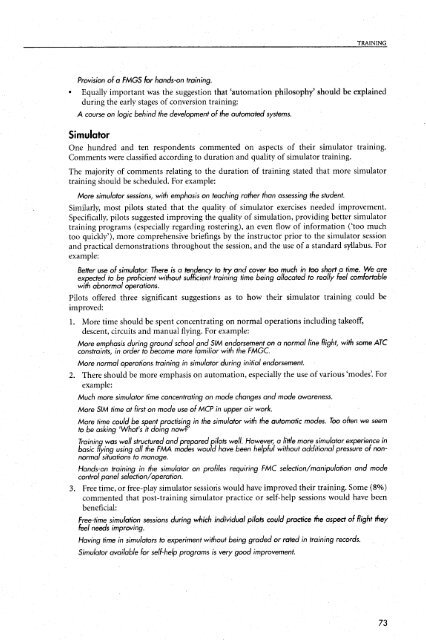Advanced Technology Aircraft Safety Survey Report - Australian ...
Advanced Technology Aircraft Safety Survey Report - Australian ...
Advanced Technology Aircraft Safety Survey Report - Australian ...
You also want an ePaper? Increase the reach of your titles
YUMPU automatically turns print PDFs into web optimized ePapers that Google loves.
Provision of a FMGS for hands-on training.<br />
Equally important was the suggestion that ‘automation philosophy’ should be explained<br />
during the early stages of conversion training:<br />
A course on logic behind the development of the automated systems.<br />
Simulator<br />
One hundred and ten respondents commented on aspects of their simulator training.<br />
Comments were classified according to duration and quality of simulator training.<br />
The majority of comments relating to the duration of training stated that more simulator<br />
training should be scheduled. For example:<br />
More sirnulator sessions, with emphasis on teaching rather than assessing the student.<br />
Similarly, most pilots stated that the quality of simulator exercises needed improvement.<br />
Specifically, pilots suggested improving the quality of simulation, providing better simulator<br />
training programs (especially regarding rostering), an even flow of information (‘too much<br />
too quickly’), more comprehensive briefings by the instructor prior to the simulator session<br />
and practical demonstrations throughout the session, and the use of a standard syllabus. For<br />
example:<br />
Better use of simulator. There is a tendency to try and cover too much in too short a time. We are<br />
expected to be proficient without sufficient training time being allocated to really feel comfortable<br />
with abnormal operations.<br />
Pilots offered three significant suggestions as to how their simulator training could be<br />
improved:<br />
1. More time should be spent concentrating on normal operations including takeoff,<br />
descent, circuits and manual flying. For example:<br />
More emphasis during round school and SIM endorsement on a normal line flight, with some ATC<br />
constraints, in order to !z ecome more familiar with the FMGC.<br />
More normal operations training in simulator during initial endorsement.<br />
2. There should be more emphasis on automation, especially the use of various ‘modes’. For<br />
example:<br />
Much more simulator time concentrating on mode changes and mode awareness.<br />
More SIM time at first on mode use of MCP in upper air work.<br />
More time could be spent practising in the simulator with the automatic modes. Too often we seem<br />
to be asking ’What’s it doing now?‘<br />
Trainin was well structured and prepared ilots well. However, a little more simulator experience in<br />
basic ing using all the FMA modes wou P d have been helpful without additional pressure of nonnorma<br />
7 situations to manage.<br />
Hands-on training in the simulator on profiles requiring FMC selection/manipulation and mode<br />
control panel selection/operation.<br />
3. Free time, or free-play simulator sessions would have improved their training. Some (8%)<br />
commented that post-training simulator practice or self-help sessions would have been<br />
beneficial:<br />
Free-time simulation sessions during which individual pilots could practice the aspect of flight they<br />
feel needs improving.<br />
Having time in simulators to experiment without being graded or rated in training records.<br />
Simulator available for self-help programs is very good improvement.<br />
73
















